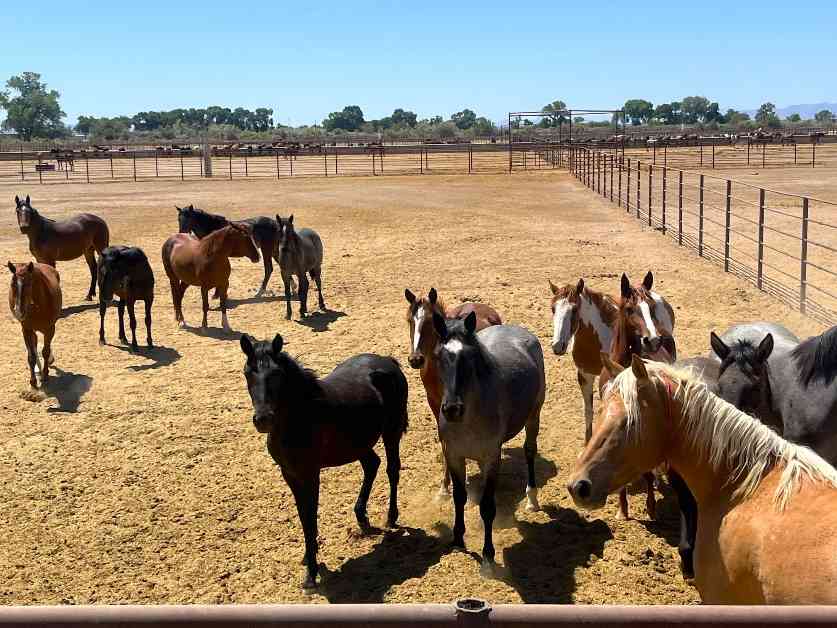Wild Horse Adoptions: Preserving Public Lands and Reducing Costs
The issue of overpopulation is a pressing concern for America’s rangelands, posing threats not only to the land itself but also to the iconic wild herds that inhabit them. Nevada, with its vast public lands, is home to more than 38,000 wild horses and burros, making it the state with the largest herds in the nation. However, this population far exceeds the state’s sustainable target, prompting wildlife officials and the Bureau of Land Management (BLM) to take action to prevent mass starvation and dehydration among the animals.
To address the growing problem of overpopulation, the BLM regularly rounds up wild horses and burros from the range, prioritizing herds that exceed sustainable numbers or face threats like drought. In 2018, nearly 200 wild horses died from dehydration on the Navajo Nation, highlighting the dire consequences of the current situation. Drought and extreme heat conditions have become increasingly common, affecting the more than 73,000 wild horses and burros that roam approximately 27 million acres of public rangelands in the American West.
The animals that are removed from the range are relocated to BLM-administered corrals and pastures, adding to the already significant population of 60,000 once-wild horses and burros. This continuous growth in herd size, both in the wild and in captivity, has resulted in an underreported ecological crisis, with the horses bearing the brunt of the impact.
In response to the escalating issue of overpopulation, the BLM implemented an adoption incentive program aimed at encouraging individuals to adopt wild horses and burros. This initiative offers a $1,000 incentive payment to those who adopt untrained animals, in addition to the standard adoption fee of $125. Since the introduction of the program, annual adoptions have more than doubled, providing a viable solution to the ecological crisis while also helping to alleviate the financial burden on the agency and taxpayers.
Challenges and Criticisms
Despite the success of the adoption incentive program, there are critics who question the effectiveness of rounding up wild horses and burros and the adoption process itself. Some advocacy groups advocate for fertility-control measures as an alternative to removals, while others raise concerns about the potential for animals to end up in foreign slaughterhouses. However, Congress has prohibited the use of BLM funds for sales that lead to slaughter or processing into commercial products, with strict penalties in place for violators.
In response to these criticisms, the BLM has revised its policies to increase oversight and ensure the welfare of the animals. The agency now delays full payment of the incentive until an adopter receives title to a horse after a year, and requires more stringent compliance sign-off by a vet or agency officer. These measures aim to address concerns about the potential abuse of the program and ensure that wild horses and burros are placed in suitable homes.
The Impact of Adoption Incentives
The adoption incentive program has proven to be a valuable tool in addressing the overpopulation of wild horses and burros, with significant cost savings for the BLM and taxpayers. Research from the Property and Environment Research Center (PERC) estimates that the program has saved taxpayers approximately $66 million to date and is projected to save around $400 million over the lifetime of the adopted animals. By incentivizing adoptions and finding homes for these animals, the program not only benefits the agency financially but also contributes to the preservation of Western ecosystems.
Adopting out one wild horse can save approximately $24,000 over its lifetime, highlighting the economic benefits of the program. With the potential to place more than 30,000 animals into private homes during its first decade, the adoption incentive program is on track to generate substantial cost savings for taxpayers while also ensuring the welfare of wild horses and burros.
In conclusion, the adoption of wild horses and burros into private homes represents a sustainable solution to the overpopulation crisis facing America’s rangelands. By incentivizing adoptions and promoting responsible ownership, the BLM is not only conserving public lands but also saving money and protecting the welfare of these iconic animals. Through continued efforts to increase adoptions and enforce program protections, the agency can address the ecological challenges posed by overpopulated wild equines while securing a brighter future for these majestic creatures.

